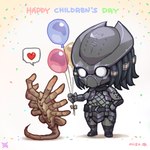
Copyright: children's day (japan)
May 5 is Children's Day in Japan (Kodomo no Hi) the last of the public holidays in Golden Week. On this day, children and their happiness are celebrated. Although Children's Day was designated as a national holiday in 1948, it has been celebrated since ancient times. Although in modern times, it recognizes both male and female children, originally, it was Tango no Sekku (Boy's Day or Feast of Banners) and meant only for boys. Some customs still have vestiges from that time.
During the Muromachi periods (1333–1573), samurai brought their armor, kabuto (helmet), and swords out of storage before the rainy season in order to care for them and, because of its timing with Tango no Sekku, show their willingness to protect their children. In the Edo period (1603–1867), this custom evolved in samurai households into using actual dolls as Gogatsu Ningyo (May doll). Ordinary households began to display paper kabuto. In the modern day, Gogatsu Ningyo are in the showier styles popular in Heian (794–1185) and Kamakura periods (1185–1333). Boys sometimes wear Kabuto of their own.and jingasa (samurai hats).
Koinobori (carp streamers) originated in the late Edo period when older traditions of flying nobori or fukinuke flags on Tango no Sekku were merged into a carp-like windsock thanks to a Chinese legend of a carp that swims upstream and becomes a dragon flying to Heaven. The koinobori of today became popular during the Meiji era (1868–1912). Black carp represent the father, a red or pink carp represents the mother, and one carp of other colors for each child. During the older Tango no Sekku, red was reserved for the eldest son and the additional color for his younger brothers.
Irises are a flower traditionally associated with this day.
More Information
Children's Day (Japan) (Wikipedia))
See also
The following tags implicate this tag: carp_streamer (learn more).
Posts (view all)



